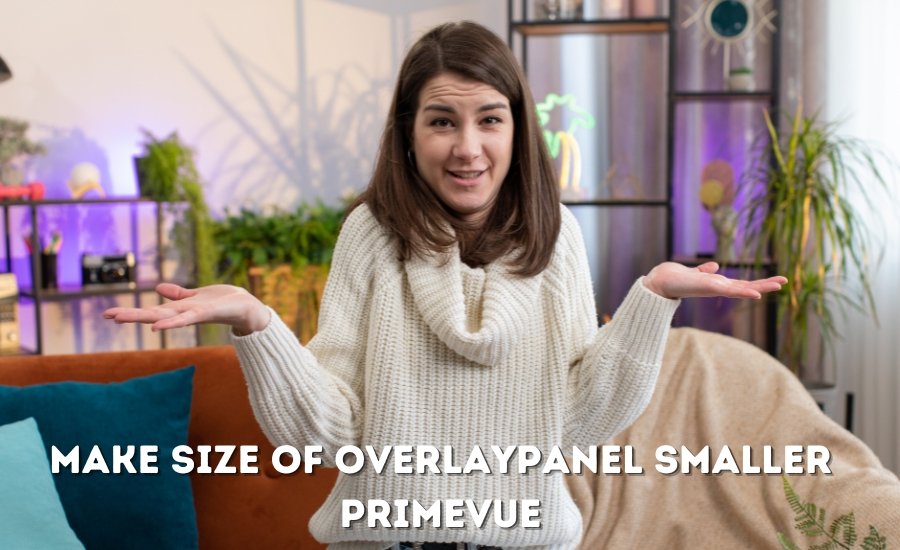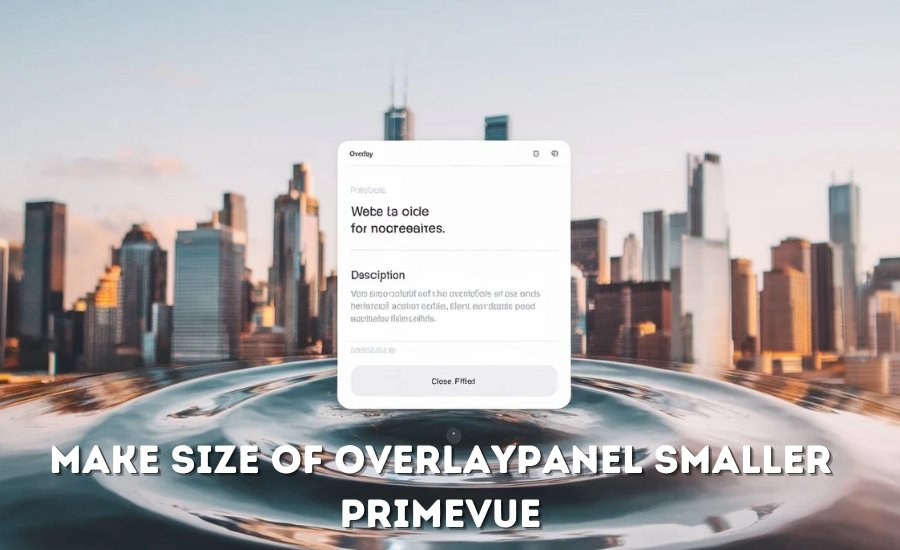How to Make Size of OverlayPanel Smaller Primevue: A Comprehensive Guide

If you’re working on a PrimeVue project and want to enhance your user interface, resizing the OverlayPanel can make a significant difference. The OverlayPanel is a useful component in PrimeVue, providing a floating panel to display additional content without cluttering your main interface. However, the default size may not always fit your design needs.
In this article, we will explore how to make size of overlaypanel smaller primevue effectively, ensuring a cleaner, more user-friendly experience. We’ll guide you through straightforward methods and practical tips to achieve this without complicated coding.
Understanding OverlayPanel in PrimeVue
What is OverlayPanel?
The OverlayPanel in PrimeVue is a dynamic UI component that pops up in response to user actions, providing an effective way to display additional information or options. Whether it’s tooltips, menus, or detailed forms, the OverlayPanel allows users to access important features without leaving their current context.
However, sometimes the default size of the OverlayPanel can be overwhelming, particularly if your interface aims for a sleek and modern aesthetic. This is where resizing comes into play.
Why Adjust the Size of OverlayPanel?
Making the OverlayPanel smaller can lead to various benefits:
- Improved User Experience (UX): A smaller panel is less intrusive and allows users to focus on the primary content without distractions.
- Sleeker UI: A minimalist approach can enhance the overall appearance of your application, making it more visually appealing.
- Better Responsiveness: A compact OverlayPanel can adapt better to different screen sizes, improving usability across devices.
Key Considerations Before Resizing
Design Consistency
When resizing the OverlayPanel, it’s vital to ensure that the new dimensions align with the overall design of your application. Consistency in design creates a harmonious user experience and avoids jarring transitions between components.
Content Relevance
As you think about resizing, consider the content inside the OverlayPanel. The size should accommodate the information without making it feel cramped. Aim for a balance where the panel is compact but still functional.
Responsive Design
In today’s digital landscape, responsive design is crucial. Your resized OverlayPanel should look great on all screen sizes, from desktops to mobile devices.
How to Make the Size of OverlayPanel Smaller in PrimeVue
1. Customizing CSS
One of the simplest and most effective ways to resize the OverlayPanel is through CSS customization. You can easily adjust the height, width, padding, and margins to create a more compact appearance. Here’s an example:
css.custom-overlay-panel {
width: 200px; /* Adjust width */
height: auto; /* Height can be auto to fit content */
padding: 10px; /* Reduce padding */
margin: 5px; /* Add some margin if necessary */
}
By applying this CSS class to your OverlayPanel, you can tailor its size to fit your design requirements.
2. Utilizing Inline Styles
For quick adjustments, you can also use inline styles directly within your Vue component. Inline styles take precedence over external CSS, making them effective for one-off customizations.
html<OverlayPanel :style="{ width: '150px', padding: '5px' }">
<!-- Content goes here -->
</OverlayPanel>
This approach is handy for dynamically adjusting the size based on certain conditions or user interactions.
3. Leveraging Scoped Slots
If you need more control over the content and layout inside the OverlayPanel, consider using scoped slots. Scoped slots allow you to customize how the content is rendered, which can be particularly useful for applying styles and sizes to specific elements.
html<OverlayPanel>
<template #content>
<div class="custom-content">
<!-- Custom content here -->
</div>
</template>
</OverlayPanel>
This method provides flexibility in managing the internal structure of the panel, allowing for specific styling and layout adjustments.
4. Implementing a Mobile-First Design Approach
When resizing the OverlayPanel, always keep mobile users in mind. Even if you’re designing primarily for desktop, ensure that the panel translates well to smaller screens.
Here’s an example of how to use media queries for responsive design:
cssCopy code@media (max-width: 600px) {
.custom-overlay-panel {
width: 90%; /* Make it wider for mobile */
padding: 8px; /* Adjust padding */
}
}
This approach ensures that your OverlayPanel maintains usability across devices.
You May Also Like: Unstability-ai-862-5790522-nj
5. Setting Intentional Padding and Margins
Strategically setting padding and margins can significantly affect how users perceive the size of the OverlayPanel. Reducing padding can make the panel appear smaller while keeping its functionality intact.
css.custom-overlay-panel {
padding: 5px; /* Adjust padding */
}
Think of it as designing a room—appropriate placement of furniture (content) can create a cozy atmosphere.
6. Creating a Focal Point for Users
A smaller OverlayPanel can direct user attention to key elements within it. By focusing on a central message or function, you enhance engagement and streamline navigation.
Common Mistakes to Avoid

Too Small to Be Functional
While it’s essential to resize the OverlayPanel, avoid making it so small that it can’t fulfill its purpose. Always ensure that the content remains legible and accessible.Users should be able to interact with the OverlayPanel without feeling frustrated by its size.
Ignoring Accessibility
Accessibility is crucial in web development. Ensure that the OverlayPanel is usable for all users, including those with disabilities. Make sure that text is readable and that all interactive elements are easily clickable, even if the panel is smaller.
Overcomplicating the Design
Sometimes, less is more. Adding unnecessary complexity to the OverlayPanel can detract from its functionality. Keep the design clean and simple to avoid overwhelming users with too much information or too many options.
Best Practices for Using OverlayPanel
Prioritize User Experience
User experience should always come first. Consider how users will interact with the OverlayPanel and design it to meet their needs. A smaller, well-designed OverlayPanel can enhance their overall experience, making it intuitive and easy to use.
Keep Content Concise
When resizing the OverlayPanel, it’s essential to deliver only the necessary information. Avoid cluttering the panel with extraneous details. Focus on the core message or functionality you want to convey to the user.
Test and Iterate
Testing is crucial in the development process. Once you’ve resized and designed the OverlayPanel, gather feedback from users to see how it performs. Use this feedback to make further adjustments and improvements. Continuous iteration will help you find the perfect balance between size and functionality.
Conclusion
Resizing the OverlayPanel in PrimeVue can significantly enhance your application’s user experience and overall aesthetic. By customizing CSS, utilizing inline styles, leveraging scoped slots, and adopting a mobile-first design approach, you can create a smaller, more effective OverlayPanel that meets your design goals.
Remember to prioritize design consistency, user experience, and accessibility as you make these changes. By following the practices outlined in this article, you can create a more engaging and user-friendly interface.
FAQs
Q: Why should I resize the OverlayPanel in PrimeVue?
A: Resizing the OverlayPanel can improve user experience by making it less intrusive and more visually appealing, allowing users to focus on the primary content.
Q: What are the best methods to resize the OverlayPanel?
A: The best methods include customizing CSS, using inline styles, leveraging scoped slots, and implementing responsive design techniques.
Q: How can I ensure my OverlayPanel is accessible?
A: To ensure accessibility, make sure that the text is readable, interactive elements are easy to click, and the content remains usable for all users, including those with disabilities.
Q: Is there a recommended size for the OverlayPanel?
A: There isn’t a one-size-fits-all answer, as the ideal size depends on your content. However, aim for a balance that allows for clear visibility of content without overwhelming users.
Q: Can I add animations to my OverlayPanel?
A: Yes! Adding subtle animations can enhance user experience, but make sure they are not too distracting or overwhelming.
Get the Latest Updates On ILOUNGE

Specializing in insightful and engaging articles across a range of topics. With a keen eye for detail and a passion for delivering high-quality information, Mary helps readers stay informed with the latest trends and updates


